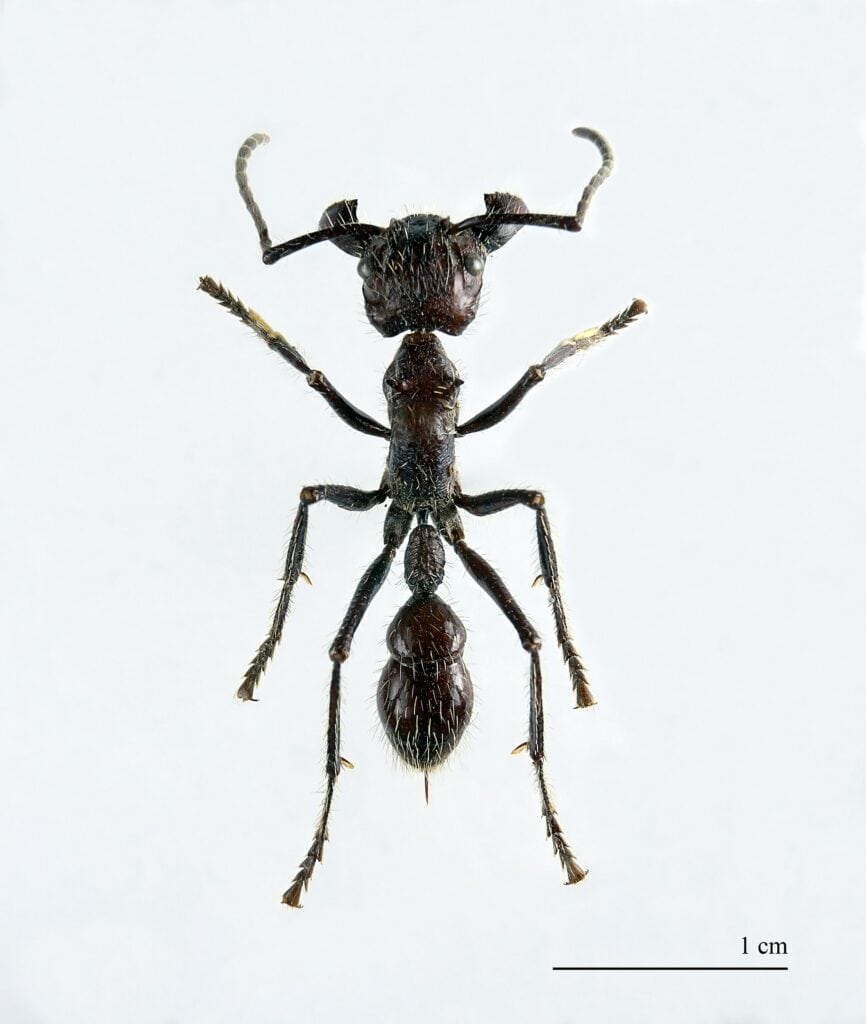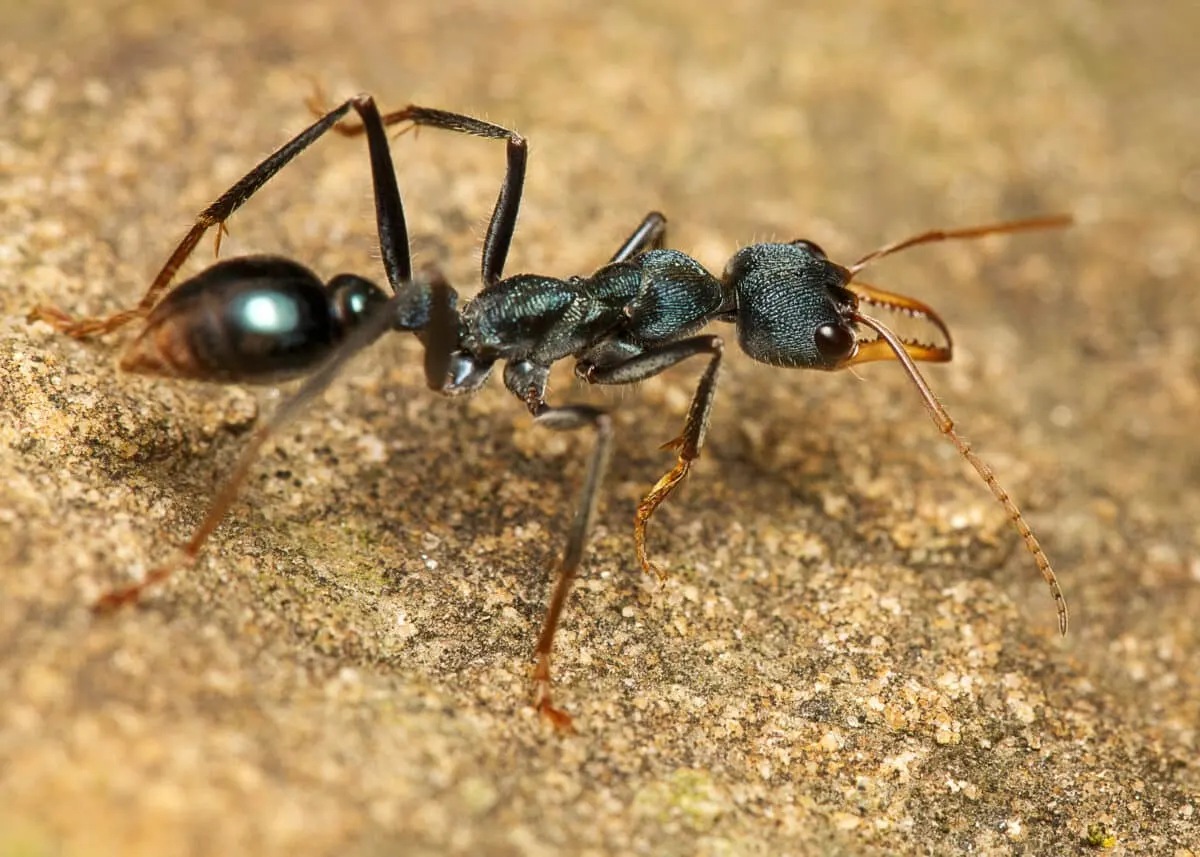Imagine a creature so tiny leaving a grown adult writhing in pain due to a sting so powerful it feels like a bullet shot. In this article, we will delve into the intriguing world of the bullet ant bite, exploring its characteristics, impact on humans, and the healthcare measures necessary when encountering this formidable creature.
Meet the Bullet Ant

Standing just over an inch in length, the bullet ant may not seem intimidating at first glance. However, its reputation precedes it. In the lush tropical rainforests of Central and South America, these ants thrive among leaf litter and low vegetation, making it their predominant habitat. They are highly adaptable insects, surviving in various environments, from humid rainforests to dry savannas.
Bullet ants have earned their name due to their distinctive appearance, resembling a sleek, elongated bullet. Their black exoskeleton creates a striking contrast with their reddish-brown legs and constricted waist. Living in large colonies with complex hierarchical structures, these formidable predators and social insects exhibit their prowess despite their small size.
If the world of insects and the wonders of nature fascinate you, consider exploring the bullet ant (Paraponera clavata) and its intriguing characteristics. For further in-depth information, you can visit the Wikipedia page on Paraponera clavata here.
The Sting of a Bullet Ant
The sting of a bullet ant is a subject of terror and curiosity, making it a topic of much research and folklore. This tiny insect wields a potent weapon in the form of neurotoxic venom, which it delivers through its stinger. When a bullet ant bites, it injects this venom into its victim, leading to a cascade of painful effects.
The venom affects the nervous system, resulting in hours of searing pain. People often describe the sensation as waves of burning, throbbing agony that radiate through the affected area. Some have likened the pain to experiencing intense waves of electricity or being subjected to scalding heat. For those who have endured the bullet ant bite, the memory of the pain lingers long after the physical wound has healed.
Interactions With Humans
While bullet ants primarily inhabit remote rainforests, human encounters with these formidable insects are not unheard of. Locals living in the regions where bullet ants are found have developed their understanding of these creatures and have adapted to coexist with them. However, for outsiders or unprepared individuals, a chance encounter with a bullet ant can be a shocking and unforgettable experience.
For researchers and entomologists, studying bullet ants poses an intriguing challenge. Understanding these insects’ behavior, venom composition, and ecological impact is crucial for comprehensively understanding the rainforest ecosystem and its delicate balance.
The Science Behind The Pain
Notably, the excruciating pain caused by a bullet ant bite is not merely a coincidence but a result of precise biological mechanisms. Bullet ant venom is a complex cocktail of chemicals designed to incapacitate prey and protect the ant colony from potential threats.
The primary component responsible for the unbearable pain is a powerful neurotoxin. This neurotoxin targets the nervous system, specifically the pain receptors, triggering an overwhelming pain response. Additionally, the venom contains other compounds that contribute to inflammation and tissue damage, prolonging the discomfort and recovery time.
Despite the intensity of the pain, scientists have found value in studying bullet ant venom. The neurotoxic properties of the venom have the potential for medical applications. Researchers are investigating its effects on pain receptors, hoping to develop new pain-relieving medications or gain insights into treating certain neurological conditions.
Fascinating Facts About Bullet Ants
Apart from their notorious sting, bullet ants possess several captivating traits that render them truly remarkable creatures:
- Social Structure: Bullet ants live in colonies with a hierarchical social structure. These colonies can house thousands of individuals, and each ant has a specific role, from foragers to defenders.
- Giant Among Ants: Among the ant species, bullet ants are considered giants, with workers reaching lengths of up to one inch. This size difference gives them a formidable advantage over many other ant species.
- Longevity: Bullet ants have relatively long lifespans compared to other insects, with workers living up to a year and queens living even longer.
- Slow Reproduction: Bullet ants have a slow reproductive rate. Colonies produce new queens and males only occasionally, making expanding their population rapidly challenging.
- Nocturnal Activity: These ants are primarily nocturnal, preferring to carry out their foraging and other activities during the cover of darkness.
- Predatory Behavior: Bullet ants are skilled predators, hunting various insects and arthropods to feed themselves and their colony members.
- Environmental Indicators: As keystone species in their ecosystems, bullet ants regulate insect populations and maintain ecological balance.
- Unique Nesting Habits: Bullet ant colonies construct large, elaborate nests of interconnected chambers within the forest floor. The construction of these nests helps aerate the soil and has implications for the overall health of the rainforest.
Frequently Asked Questions
How painful is a bullet ant bite on the Schmidt Sting Pain Index?
The bullet ant bite is considered the most painful sting on the Schmidt Sting Pain Index, with a rating of 4+. This means the pain is exceptionally intense and can be long-lasting.
Can a bullet ant bite be life-threatening to humans?
While the pain from a bullet ant bite can be excruciating, it is not typically life-threatening for healthy individuals. However, some people may experience severe allergic reactions, requiring immediate medical attention.
Are there any natural cures or aids to ease the discomfort caused by a bullet ant sting?
Though no specific natural remedies are proven to alleviate the pain, some local communities use traditional methods to mitigate the discomfort. These remedies may include applying plant extracts or poultices to the sting site. However, their effectiveness can vary, and seeking professional medical advice for appropriate treatment is essential.
Conclusion
Remember, prevention is the best approach to dealing with a bullet or bite. When venturing into their natural habitat, always exercise caution and take necessary precautions to avoid potentially painful encounters.
As we conclude this exploration into the world of bullet ant bites, it’s important to recognize the intricate balance of nature and the diverse array of species, big and small, that play vital roles in the ecosystems they inhabit. Understanding and respecting these fascinating creatures can lead to coexistence, benefiting humans and the natural world.
If you enjoyed reading this blog, you may find some of our other blogs really interesting! For example:
11 Astonishing Flying Spiders Facts
Where To See Black Widow Spider?
Meet the Zombie Fungus that Mind controls insects.
Florida’s Feisty Insects: Fire Ants
Join our Forum for free today!

- Usain Bolt vs. Peregrine Falcon – Speed Test in Their Domains - May 18, 2024
- Top 10 Animals in Yellowstone National Park - April 12, 2024
- Top 10 Omnivores - March 9, 2024




